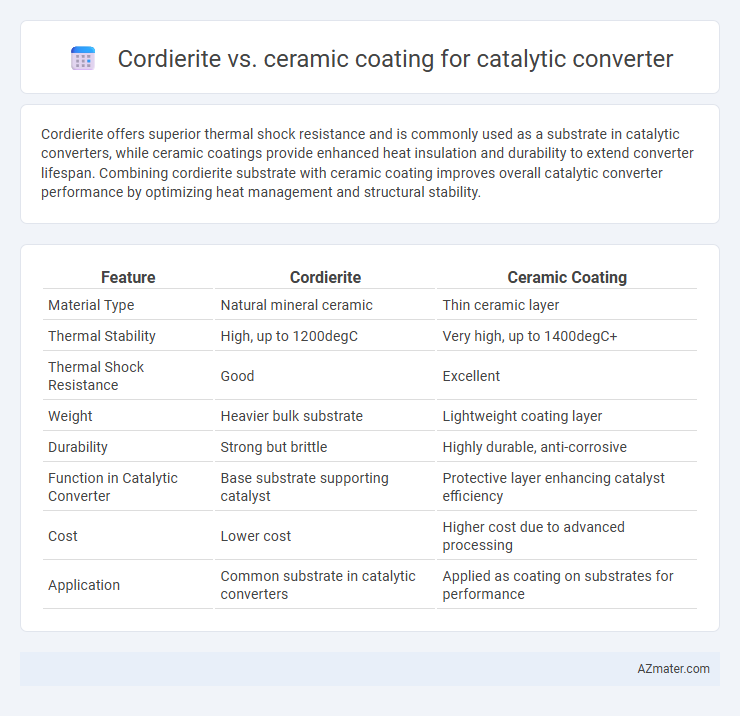Cordierite offers superior thermal shock resistance and is commonly used as a substrate in catalytic converters, while ceramic coatings provide enhanced heat insulation and durability to extend converter lifespan. Combining cordierite substrate with ceramic coating improves overall catalytic converter performance by optimizing heat management and structural stability.
Table of Comparison
| Feature | Cordierite | Ceramic Coating |
|---|---|---|
| Material Type | Natural mineral ceramic | Thin ceramic layer |
| Thermal Stability | High, up to 1200degC | Very high, up to 1400degC+ |
| Thermal Shock Resistance | Good | Excellent |
| Weight | Heavier bulk substrate | Lightweight coating layer |
| Durability | Strong but brittle | Highly durable, anti-corrosive |
| Function in Catalytic Converter | Base substrate supporting catalyst | Protective layer enhancing catalyst efficiency |
| Cost | Lower cost | Higher cost due to advanced processing |
| Application | Common substrate in catalytic converters | Applied as coating on substrates for performance |
Introduction: Understanding Catalytic Converter Substrates
Catalytic converter substrates are crucial components designed to support the catalyst material and facilitate efficient exhaust gas treatment. Cordierite, a ceramic material with excellent thermal stability and low thermal expansion, is commonly used due to its lightweight and cost-effectiveness. In contrast, ceramic coatings enhance substrate durability and resistance to thermal shock, improving overall catalytic converter performance and longevity.
What Is Cordierite? Properties and Benefits
Cordierite is a crystalline mineral composed primarily of magnesium, iron, aluminum, and silicon, known for its excellent thermal stability and low thermal expansion. Cordierite ceramic substrates in catalytic converters provide high resistance to thermal shock and mechanical stress, improving durability and efficiency in reducing emissions. Its porous structure allows effective gas flow and optimal catalyst dispersion, enhancing the overall performance of the catalytic converter compared to traditional ceramic coatings.
What Is Ceramic Coating? Overview and Applications
Ceramic coating is a high-temperature resistant layer primarily composed of silicon dioxide (SiO2) used to protect catalytic converters from thermal damage and corrosion. It enhances heat dissipation, reduces thermal degradation of the substrate, and improves the longevity and efficiency of exhaust system components. Common applications include automotive exhaust parts, turbochargers, and industrial machinery where thermal protection and chemical resistance are critical.
Thermal Performance: Cordierite vs Ceramic Coating
Cordierite, primarily used in catalytic converter substrates, offers moderate thermal conductivity and excellent thermal shock resistance, enabling it to withstand rapid temperature fluctuations without cracking. Ceramic coatings applied to catalytic converters enhance thermal performance by providing a high-temperature resistant barrier that improves heat retention and protects underlying materials from thermal degradation. Compared to cordierite alone, ceramic coatings improve overall thermal efficiency by reducing heat loss, which enhances catalyst reaction rates and durability under high operating temperatures.
Durability and Longevity Comparison
Cordierite catalytic converters offer moderate durability with thermal stability up to 1,200degC but tend to crack under extreme thermal cycling, leading to reduced longevity. Ceramic coatings enhance durability by providing superior thermal resistance, corrosion protection, and improved heat retention, significantly extending the lifespan of the catalytic converter. Studies show ceramic-coated converters maintain structural integrity and efficiency longer than cordierite counterparts, especially in high-stress automotive environments.
Cost Analysis: Cordierite vs Ceramic Options
Cordierite catalytic converters are generally more cost-effective due to lower material and manufacturing expenses, making them a budget-friendly option for many vehicles. Ceramic coatings, while initially more expensive, offer superior thermal resistance and durability, potentially reducing long-term maintenance costs by preventing substrate degradation. Evaluating the total cost of ownership reveals that ceramic-coated converters may provide better value over time despite higher upfront investment.
Emissions Control Efficiency
Cordierite catalytic converters offer effective thermal resistance and durability, promoting stable emissions control by maintaining optimal operating temperatures for catalytic reactions. Ceramic coatings enhance emissions control efficiency by improving heat retention and resistance to thermal shock, leading to faster catalyst light-off and reduced harmful pollutant output. Comparing both, ceramic coatings provide superior protection against temperature fluctuations, resulting in more consistent and lower emissions than standard cordierite substrates.
Installation and Maintenance Considerations
Cordierite catalytic converters require careful installation to avoid cracking due to their brittle ceramic composition, necessitating proper mounting and vibration isolation techniques. Ceramic-coated catalytic converters offer enhanced durability and thermal resistance, reducing the frequency of maintenance and improving longevity under high-temperature conditions. Maintenance for cordierite units often involves vigilant inspections for physical damage, while ceramic coatings simplify upkeep by providing better protection against thermal shock and contamination.
Suitability for Different Vehicle Types
Cordierite catalytic converters offer excellent thermal shock resistance, making them suitable for most passenger vehicles and light trucks operating under moderate driving conditions. Ceramic coatings enhance durability and thermal insulation, benefiting high-performance and heavy-duty vehicles that experience elevated exhaust temperatures and frequent thermal cycling. Selecting between cordierite and ceramic coatings depends on vehicle type, engine heat output, and driving patterns, with ceramic-coated converters preferred for demanding applications.
Choosing the Right Substrate for Your Catalytic Converter
Cordierite offers excellent thermal shock resistance and is ideal for standard catalytic converters operating at moderate temperatures, while ceramic substrates provide superior durability and higher temperature tolerance, enhancing performance in high-demand applications. Selecting the right substrate depends on the vehicle's emission requirements, operating environment, and longevity expectations. Ceramic coatings improve catalyst adhesion and thermal management, extending converter lifespan and efficiency compared to traditional cordierite materials.

Infographic: Cordierite vs Ceramic coating for Catalytic converter
 azmater.com
azmater.com